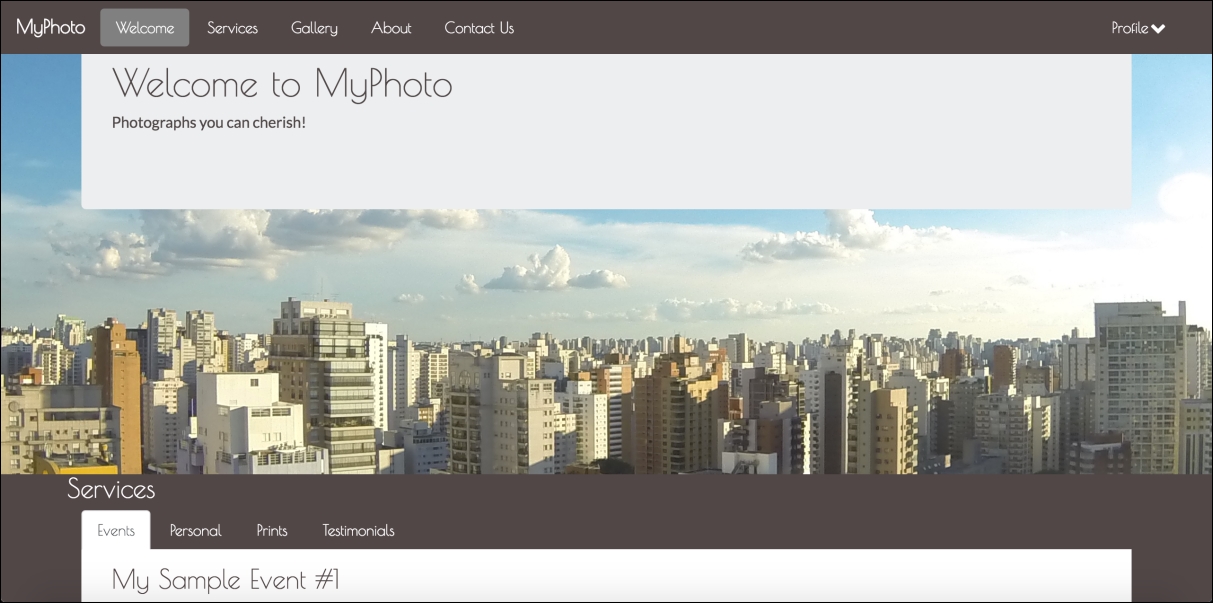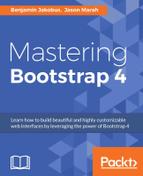Bootstrap is a web development framework that helps developers build web interfaces. Originally conceived at Twitter in 2011 by Mark Otto and Jacob Thornton, the framework is now open source and has grown to be one of the most popular web development frameworks to date. Being freely available for private, educational, and commercial use meant that Bootstrap quickly grew in popularity. Today, thousands of organizations rely on Bootstrap, including NASA, Walmart, and Bloomberg. According to BuiltWith.com , over 10% of the world's top 1 million websites are built using Bootstrap (http://trends.builtwith.com/docinfo/Twitter-Bootstrap). As such, knowing how to use Bootstrap will be an important skill and will serve as a powerful addition to any web developer's tool belt.
The framework itself consists of a mixture of JavaScript and CSS, and provides developers with all the essential components required to develop a fully functioning web user interface. Over the course of this book, we will be introducing you to all of the most essential features that Bootstrap has to offer by teaching you how to use the framework to build a complete website from scratch. As CSS and HTML alone are already the subject of entire books in themselves, we assume that you, the reader, has at least a basic knowledge of HTML, CSS, and JavaScript.
We begin this chapter by introducing you to our demo website, MyPhoto. This website will accompany us throughout this book, and serve as a practical point of reference. Therefore, all lessons learned will be taught within the context of MyPhoto.
We will then discuss the Bootstrap framework, listing its features and contrasting the current release to the last major release (Bootstrap 3).
Last but not least, this chapter will help you set up your development environment. To ensure equal footing, we will guide you towards installing the right build tools, and precisely detail the various ways in which you can integrate Bootstrap into a project. More advanced readers may safely skip this last part and continue to Chapter 2 , Making a Style Statement.
To summarize, this chapter will do the following:
- Introduce you to what exactly we will be doing
- Explain what is new in the latest version of Bootstrap, and how the latest version differs to the previous major release
- Show you how to include Bootstrap in our web project
This book will teach you how to build a complete Bootstrap website from scratch. Starting with a simple layout in
Chapter 2
, Making a Style Statement and
Chapter 3
, Building the Layout, we will build and improve the website's various sections as we progress through each chapter. The concept behind our website is simple: to develop a landing page for photographers. Using this landing page, (hypothetical) users will be able to exhibit their wares and services. While building our website, we will be making use of the same third-party tools and libraries that you would if you were working as a professional software developer. We chose these tools and plugins specifically because of their widespread use. Learning how to use and integrate them will save you a lot of work when developing websites in the future. Specifically, the tools that we will use to assist us throughout the development of MyPhoto are Bower, node package manager (npm), and Grunt.
From a development perspective, the construction of MyPhoto will teach you how to use and apply all of the essential user interface concepts and components required to build a fully functioning website. Among other things, you will learn how to do the following:
- Use the Bootstrap grid system to structure the information presented on your website
- Create a fixed, branded, navigation bar with animated scroll effects
- Use an image carousel for displaying different photographs, implemented using Bootstrap's
carousel.jsand jumbotron (jumbotron is a design principle for displaying important content). It should be noted that carousels are becoming an increasingly unpopular design choice; however, they are still heavily used and are an important feature of Bootstrap. As such, we do not argue for or against the use of carousels as their effectiveness depends very much on how they are used, rather than on whether they are used. - Build custom tabs that allow users to navigate across different contents
- Use and apply Bootstrap's modal dialogs
- Apply a fixed page footer
- Create forms for data entry using Bootstrap's input controls (text fields, text areas, and buttons) and apply Bootstrap's input validation styles
- Make best use of Bootstrap's context classes
- Create alert messages and learn how to customize them
- Rapidly develop interactive data tables for displaying product information
- Use drop-down menus, custom fonts, and icons
In addition to learning how to use Bootstrap 4, the development of MyPhoto will introduce you to a range of third-party libraries such as Scrollspy (for scroll animations), SalvattoreJS (a library for complementing our Bootstrap grid), Animate.css (for beautiful CSS animations, such as fade-in effects at
https://daneden.github.io/animate.css/
), and Bootstrap DataTables (for rapidly displaying data in tabular form).
The website itself will consist of different sections:
- A Welcome section
- An About section
- A Services section
- A Gallery section
- A Contact Us section
The development of each section is intended to teach you how to use a distinct set of features found in third-party libraries. For example, by developing the Welcome section, you will learn how to use Bootstrap's jumbotron and alert dialogs along with different font and text styles, while the About section will show you how to use cards. The Services section of our project introduces you to Bootstrap's custom tabs. That is, you will learn how to use Bootstrap's tabs to display a range of different services offered by our website.
Following on from the Services section, you will need to use rich imagery to really show off the website's sample services. You will achieve this by really mastering Bootstrap's responsive core along with Bootstrap's carousel and third-party jQuery plugins. Last but not least, the Contact Us section will demonstrate how to use Bootstrap's form elements and helper functions. That is, you will learn how to use Bootstrap to create stylish HTML forms, how to use form fields and input groups, and how to perform data validation.
Finally, toward the end of the book, you will learn how to optimize your website, and integrate it with the popular JavaScript frameworks AngularJS (https://angularjs.org/) and React (http://facebook.github.io/react/). As entire books have been written on AngularJS alone, we will only cover the essentials required for the integration itself.
Now that you have glimpsed a brief overview of MyPhoto, let's examine Bootstrap 4 in more detail, and discuss what makes it so different to its predecessor. Take a look at the following screenshot:

Figure 1.1: A taste of what is to come: the MyPhoto landing page
